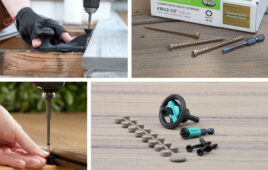Article contributed by UC Components

Uniquely designed fasteners are available that reduce galling. Research your options before use. Without the hassle of galled or stuck fasteners, downtime is minimized.
Galling — also called cold-welding or cold-fusing — happens when two fastener surfaces are placed under heavy pressure and lock together. Thread galling can occur when pressure and friction cause the bolt threads to seize to the threads of a nut or a tapped hole. Essentially, it’s a rapid form of wear and tear.
This is a frustrating problem because it occurs quite regularly during installation when fasteners are tightened. Galling is rarely a gradual process and is typically more common in alloys that self-generate an oxide surface film for corrosion-protection, such as stainless steel, aluminum, and titanium.
What’s more is that galled nuts and bolts may pass all of the required inspections (such as for mechanical, threads, material strength, etc.) and still fail to function properly.
Why does galling happen so easily?
When two fasteners are tightened together pressure builds between the contact threads and this can break the oxide coatings on the components. Without this protective layer, the exposed metals rub against one another, generating heat. Eventually, they’ll fuse together.
With minor galling, it’s possible to remove the fasteners without too much difficulty. However, in severe cases, the fastener surfaces will completely fuse, making it nearly impossible to remove them without cutting the bolt or splitting the nut. Despite this tight hold that ensures the fasteners will not loosen (which is usually a good thing in fastening), the affected galled joints can still fail from fatigue.
As a result, the parts can become stripped, sheared, or twisted off completely, negatively affecting the overall quality, reliability, and durability of the fasteners and the application. Galling can also increase maintenance and repair costs because the fasteners will need to be removed and replaced, and any holes left in the application will require filling.
In high or ultra-vacuum systems, the materials can become cold-fused together due to thermal expansion and a lack of moisture created by the vacuum. Screws threaded into blind-tapped holes are often affected by galling and components made of stainless steel are particularly susceptible.
Can galling be avoided?
Unfortunately, little is known on how to completely control galling, but it can be minimized. Material choices matter and those that possess low, work-hardening rates are often prone to galling, so choose wisely.

Galling is a common type of wear that can occur when fastening or disassembling threaded components. It can result in damage or seizing of these components.
One of the best ways to avoid galling is to use a lubricant or an “anti-seize” product. Such lubricants are available in several varieties and many are specifically formulated for use on alloys.
It’s worth noting that in certain applications, such as with ultra-high vacuum systems and other clean applications, the use of anti-seize lubricants is not a viable option. This is because it presents too much risk of contamination and an unclean interior of the vacuum chamber. In such cases, another option is necessary, which may involve using different alloys.
Before choosing the ideal fasteners for an application, first consider the factors that can impact galling, including the design (of the fastener and the application), the applied load and degree of movement expected, and the surface finish and hardness.
A few ways to minimize galling:
• Use a finish, such as a coating or plating, that’s made to prevent galling
• Design components using different alloys to lower the possibility of galling
• Choose fasteners with smoother surfaces to reduce friction
• Use coarse rather than fine threads, such as a 2A- 2B fit —they have a larger thread allowance and can handle greater wear and tear
• Slow the assembly speed of a threaded fastener to reduce the chances of heat buildup and galling
• Consider the design tolerances, ensuring a tight enough mechanical fit to prevent vibration and wear, but with sufficient clearance to prevent galling
• Always use the proper installation torque and never over-tighten fasteners
• Any debris in the threads of a fastener can greatly increase the chances of galling so always use clean parts
Balancing a fasteners’ properties to get the best performance while preventing galling is possible, but not easy.






Tell Us What You Think!